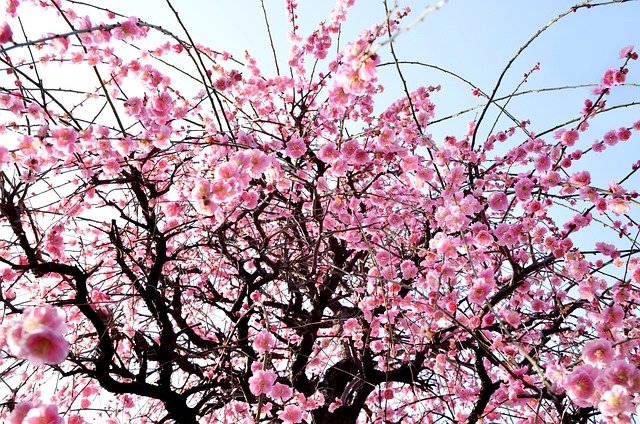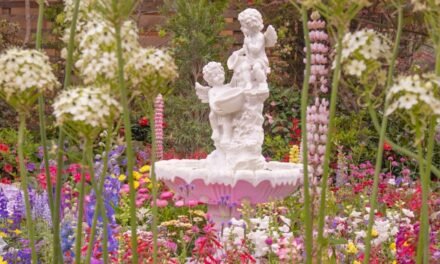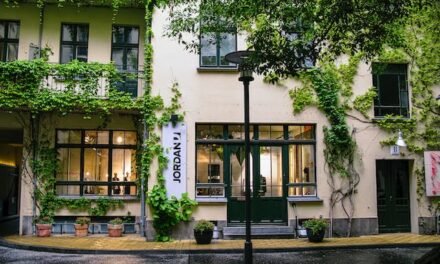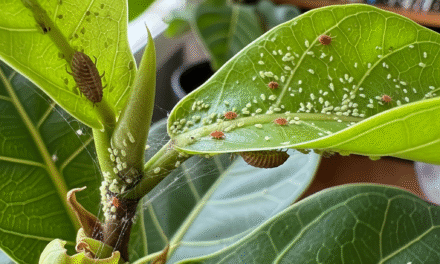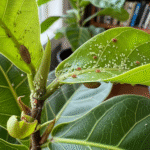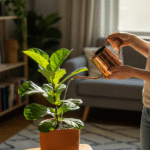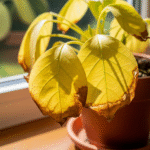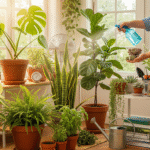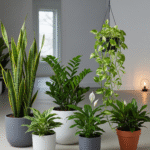Welcome to the home of Purple Leaf Plants.
Purple foliage plants, like other species with a striking leaf color, are admired for their fascinating leaves which confer a magical aura to any garden or interior space. The leaves which vibrate from dark violet to a beautiful burgundy, are a source of fascination, which simultaneously draws the eye as well as admiration. These plant-based wonders perform not only as novelty items but also impart certain charm and allure to the general atmosphere.
Unique Foliage Coloration and Textures
The feature that best describes the purple leaf plants is the color of their foliage, which is the most prominent characteristic. Colors like velvety plum and intense magenta provide an eye-catching visual contrast to the plain green background, which adds to the character of the landscape with a neo-dramatic style. Furthermore, the softness of their leaves will make the leaves even more appealing. Some of them revel in their soft texture that makes you want to touch; some boast exquisite patterns or serrated borders that add a touch more elegant to them.
Other than their visual appeal, purple leaf plants are also capable of bringing out the beautiful palette of color. During the process of changing the seasons, their foliage might be from purple in the cold and red in the fall, continue to generate visual enjoyment and pleasure.
Versatility in Garden Design
The flexibility of purple-leaved plants makes them essential elements for [the art] of garden design. From a bespoke contrasting highlight to a layering landscape enhancement, there is an array of creative uses for these plants. As formal gardens or casual landscapes, they make themselves easily seen and add appeal to the whole by their brightness.
Furthermore, a lot of the purple leaf plants exhibit additional characteristics that make them distinctive from others than only their stunning foliage. Others have flowers which are as delicate as flower petals, in contrasting colors giving the garden more ornamental purpose and it also attracts pollinators. Furthermore, some cultivars may have flavored leaves or edible foliage, another reason for their decorative value.
Adaptability and Maintenance
The varieties of the Purple leaf plant show a high degree of adaptability to different growing conditions which makes them good plants for many environments. On the one hand, some plants do well in the full sun and well-drained soil, while some other plants grow better in the partial shade and the moist, rich loam. Determining the specific needs of each variety is one of the key factors that often determine the success of their production.
Purple leaf plants may be eye-catching, but they surprise us with their easy-going nature: little maintenance is required for them to thrive. Appropriate arrangements comprising of regular watering, occasional pruning and necessary fertilization ensure the growth of these plants, hence adding a captivating feature in the garden for a longer period.
In addition, purple leaf plants work great for container gardening and make a terrific choice for people who do not have much garden space. Therefore, individuals who live on balconies, patios or even indoors, would be able to enjoy the ornamental beauty of this plant. Compact size and decorative foliage make them excellent choices as colorful, eye-catching additions to any setting, even if its small or out of the way.
Cultural and Symbolic Significance
Royalty is one area where purple has a particular place in human history among other countries, representing wealth and even spirituality. Hence, such plants are shrouded in mystery and luxury aura the moment they are cultivated, and their surrounding flaunts the sense of complex and exposed beauty. Whether being woven into sculpted gardens, used as therapeutic landscaping, or planted in personalized sanctuaries, these plants embody a feeling of splendor and awe that enhance the human being with their visual impact.
Mentioned below is the description of the various types of Purple Leaf plants which we will be covering starting from the Indoor Species to the Vine species. Would you enjoy the same? Here we go!
You can find a lot of different types of purple leaf plants.
Take a walk on the wild side (literally!), as we venture into the wondrous and colourful realm of purplish-leafed plants! These exotic plants spruce up every ecoregion, from the luscious rainforests in the tropics to the harsh mountain tops of distant lands, with their beautiful purple color of their leaves. Every species is special with its own kind of charm, from the delicate growth of creeping weeds to the striking presence of stately trees. As we journey through this botanical wonderland, we encounter an array of treasures: ranging from luxurious velvet foliage of the Purple Heart plant to its subtle fronds of the Japanese Painted Fern and each giving a peek into the spoils of nature’s mastery. Come with us on this awe-inspiring journey into the life of these captivating plants where dreamlike beauty holds no limits and every leaf is a story that opens like a fairy-tale.
Indoor Purple Leaf Plants
First off, the GLORIOUS Mystiques of Nature that bring the Nature’s Beauty to your House, I present to you the “Indoor Purple Leaf Plants”:
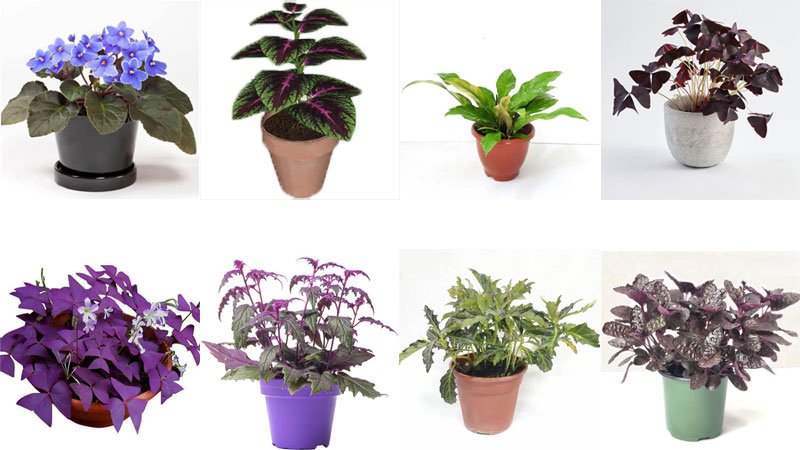
Purple Heart (Tradescantia pallida):
The trailing plant, which is quite favourite, possesses showy purple leaves that dangle gracefully, either in the hanging baskets or over the edges of pots. Caring for it is easy plus it brings in some touch of color to any indoor area.
Purple Waffle Plant (Hemigraphis alternata):
An outstanding feature of this compact plant is that brings our breakfast analogy: its uniquely textured leaves resemble waffles, while its deep purple foliage has hints of silver. It is best suited for bright, indirect, and when placed on tabletops or shelves, adds an airy charm.
Purple Velvet Plant (Gynura aurantiaca):
Famous for those velvety, glossy leaves, which vary from dark purple to bright green, this plant is a real gem for indoor gardens. on it, used is sufficiently bright, indirect lighting, and too propagate necessity of regular watering to maintain its lush visage.
Purple Passion Plant (Gynura sarmentosa):
The plant possesses purple fluff leaves and green stems that stands out. It does well in medium to bright light with no specialized care and will add vibrancy to any decor.
Purple Shamrock (Oxalis triangularis):
Distinguished by its three-pointed leaves and attractive pinkish-purple blossoms, this plant exists for the purpose of beautification and decoration of interiors. It is partial to partial shade; therefore, you should grow it in bright light indoors or containers with very good drainage facilities.
Purple Persian Shield (Strobilanthes dyerianus):
The plant featured has silver-coated purple leaves and thus brings an element of drama in to indoor gardens. It requires a bright, indirect light and needs regularly trimming to grow a full bush.
Purple Velvet Vine (Gynura pseudochina):
The hanging plant bears leaves of deep wine color, soft and velvety with a lustrous shine which makes it perfect for tall containers or baskets. It lives up to its name as it is best in bright indirect light, and it needs regular watering just to keep the soil moist.
Purple Oxalis (Oxalis triangularis ‘Purple Shamrock’):
This variety also features this purple pipe leaf that fold down every night, and unfolds again by morning, making it unique. It loves bright, diffused indoors light and moderate watering.
Purple Coleus (Solenostemon scutellarioides):
Standing out with its rich violet-purple foliage carved with the refined patterns of dark green, it yet gives the extra touch of color to the indoor gardens. It thrives in bright, indirect light and regular pinching is required to retain the compact form.
Purple African Violet (Saintpaulia spp.):
These enchanting flowering plants have fluffy leaves that range in color from the deepest purple to lightest purple, with corresponding tiny blooms that can be pink, white, or purple. They grow best in bright surroundings with indirect light, and they need the air to be humid to do well indoors.
Outdoor Purple Leaf Plants
Next off, the SUPREME Agents of Nature that demand your attention whenever you go out to discover your destiny, I present to you the “Outdoor Purple Leaf Plants”:
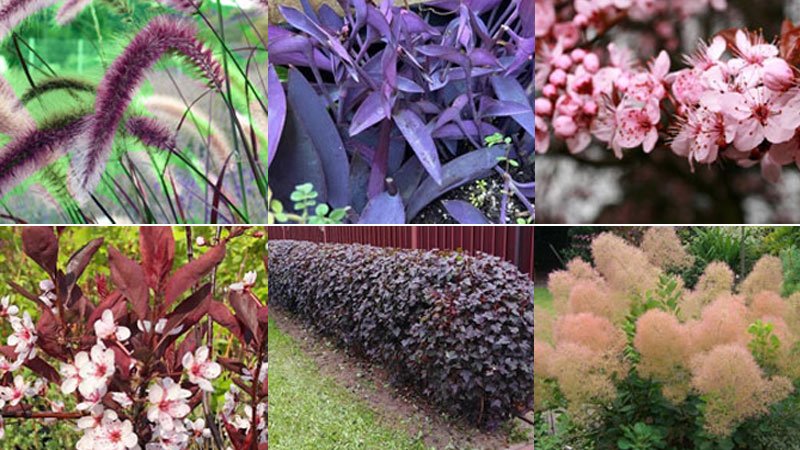
Purple Fountain Grass (Pennisetum setaceum ‘Rubrum’):
This grass species has beautiful arched stems of burgundy-purple blades, it can provide movement and texture in your garden. It can grow in full sun and in conditions with good drainage, so it is often used for borders or for masses of plants.
Purple Smoke Bush (Cotinus coggygria):
With its capacious clouds of purple leaves, this deciduous shrub is very conspicuous and adds color to the outdoors in a garden. It grows best in full sun, moderate dose of fertilizer and well drained fertile soil, developing beautiful foliage in a variety of color combinations. This process can not anticipate the natural weather conditions, which often include unexpected temperature variations, rainfall, humidity, wind, storms, or seismic events.
Purple-Leaf Sand Cherry (Prunus x cistena):
This shrub only takes up limited space but has dark purple evergreen foliage color which is maintained throughout the growing season and therefore adds more life-long interest to the landscape. It favours full sunlight and well-drained soil, then delivers delicate pink flowers in the spring.
Purple Heart Vine (Setcreasea pallida):
Several purple stems and its cascading nature make it the ideal ornamental vine to plant in containers, hanging baskets, garden edges. It is appreciated in areas ranging from full sun to partial shade and needs watering regularly in order to keep its luscious appearance.
Purple Leaf Plum (Prunus cerasifera):
This compact birch tree has wine-red foliage and is one of the first to bloom in the spring, standing out amongst other plants in outdoor landscapes. It requires full sunlight and well-adapted soil, which produce edible small fruits in summer season.
Purple Majesty Ornamental Millet (Pennisetum glaucum ‘Purple Majesty’):
This shrubby, spiky, purple grass is remembered by the name of “Maiden Grass” because of the striking visual during the flowering season. It prospers in full sun and in well-drained soil, thus the strong appeal for use as a border plant or in containers.
Purple Ninebark (Physocarpus opulifolius ‘Diablo’):
The dark purple leaves, and the arching branches of this deciduous shrub, create an elegant and structural design that is ideal for garden spaces. It thrives under full sun but can tolerate some shade too. And its blooms are white bunches sprouting in the spring.
Perennial Purple Leaf Plants
Next up on our List, we have our EVER-LASTING Beauties that can Survive the Tough Trials of Nature for a long time, I humbly present to you the “Perennial Purple Leaf Plants”:
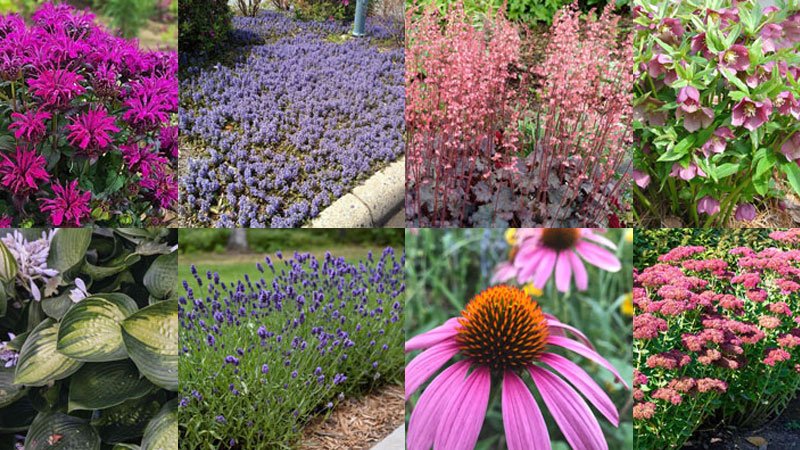
Purple Coneflower (Echinacea purpurea):
This plant is a perennial which can be grown in gardens. It is known for its purple-pink flowers with tall stems and solid green leaves. It appears during the last spring and the early fall and provides nectar for the pollinators such as butterflies and bees. Purple Coneflower grows in drought and can withstand full sun to partial shade conditions.
Catmint (Nepeta spp.):
Catmint, a perennial with a low requirement for maintenance, has foliage that is fragrant and spikes of lavender-purple flowers. It blossoms from spring to fall and welcomes pollinators. This includes butterflies and bees. Cat mint is a sun loving and well-drained soil categorizer.
Russian Sage (Perovskia atriplicifolia):
A fragrant plant with silvery-gray foliage and airy short spikes of lavender-purple flowers, Russian sage accentuates the texture and color in the garden. It flowers in mid-summer to autumn and is best grown in full or morning sun and well-drained soil.
Lavender (Lavandula spp.):
The foliage and the spikes of purplish-blue flowers of lavender are especially prized. It flowers in late spring and summer and is often grown in herb gardens and borders and will also do well in containers. Lavender likes gardening in the sunshine and in deep bedding soil.
Bugleweed (Ajuga reptans):
This prostrate perennial forms ground-covering clumps of lush, velvety, purple-green leaves and sky-high, blue-violet flower spikes in the spring. Bugleweed works really well as a ground cover in shady places and can withstand partial to full shade, getting moist, but well drained soil.
Hellebore (Helleborus spp.):
More commonly known as the Lenten Rose, this hellebore also features flowers that hang elegantly and come in shades of purple, pink, or white. Late winter to spring is timing of blooming for it and it requires partial to full shade with good drainage.
Sedum (Sedum spp.):
Sedum, commonly known as Stonecrop, is a succulent drought-tolerant perennial with leaves that can grow in several shades, from purple to pink or white and star-shaped flowers. It flowers in late summer to fall and loves growing in full sun and it needs the soil to be well drained.
Hosta (Hosta spp.):
Hosta is valued for its versatile foliage and ability to survive in floods, thus being the ideal plant for shady gardens. Catering to lovers of the unusual and the offbeat, various kinds feature purple hued or variegated leaves. Hostas, long straplike leaves of perennials, produce lavender-purple colour spikes in summer while the favorites of partial shade to full shade and moist, well-drained soil.
Coral Bells (Heuchera spp.):
Coral Bells with their beautiful colourful foliage in shades of purple, burgundy, green and silver are admired as well. They are possessing fine spikes of flowers in the spring and could be used for borders or great for artificial rock gardens or containers. Coral Bells like partial shade and they do well in moist but well-draining soil.
Bee Balm (Monarda spp.):
Bee Balm, which is also known as Bergamot, has tubular flowers arranged in clusters and comes in colors like purple, pink, and white or red. It blooms from midsummer till fall and draws nature’s pollinators: hummingbirds and butterflies. Like most bee balms, it thrives in full sun to partial shade and grows best in moist, well-drained soil.
Landscape Purple Leaf Plants
Moving on, the Species which we are going to be discussing now are rather wide-spread across the world because these Majesties of Nature are everywhere to beautify our World and make it visually appealing to our eyes. That said, I present to you the “Landscape Purple Leaf Plants”

Purple Fountain Grass (Pennisetum setaceum ‘Rubrum’):
This ornamental grass is distinguished by the self-supporting, arching blades of burgundy-purple, add the movement and texture to the outdoor area. It is very good choice for borders or mass plantings, due to the fact that it likes full sun and well-drained soil.
Purple Smoke Bush (Cotinus coggygria):
The bush with the ruffled leaves of purple foliage is truly outstanding in the garden due to its bright color, so it makes amazing visual impact. It requires a full sun or partial shade exposure with good drainage, which results in its velvety foliage that gets even more vivid during the fall as winter approaches.
Purple-Leaf Sand Cherry (Prunus x cistena):
Purple foliage of the compact shrub is so deep that the leaves hold its color for the entire plant period, creating year-round interest to the outdoor landscape. It is native to full sun and good drainage, putting out pink blossoms in the spring.
Purple Heart Vine (Setcreasea pallida):
Being the distinctive feature of this trailing vine, its leaves are purple-hued, giving it a unique accent to the garden borders and containers as well. It prefers to be placed in full sun or partial shade and needs to be watered frequently to sustain its leaved glamour.
Purple Japanese Maple (Acer palmatum):
Adorned with its delicate leaves and charming form, this little tree translates into an elegant addition to a garden. It can withstand partial shade and well-drained soil that gives the stunning foliage in the spring that transitions into red or orange in the fall.
Purple Coral Bells (Heuchera spp.):
Such plants resemble trees in their habit and are characterized by colorful leaves in shades of purple, often accompanied by spikes of beautiful flowers in shades of pink or white. They do well in partial shade or well-drained soil and are, therefore, good for borders, rock garden or container planting.
Purple Ninebark (Physocarpus opulifolius ‘Diablo’):
It boasts its dark purple leaves, the shrub uses its curved branches with uniqueness and thus provides elegance and structure to the outdoor space. It thrives in full sun but can also tolerate partial shade and well-drained soil; in the spring it produces clusters of white blooms.
Purple Coneflower (Echinacea purpurea):
This famous perennial manifests tall stalks of purple-pink blooms supported by strong stems and deep blue-green foliage. It blooms from late spring until early fall and serves as a vital source of pollinators including butterflies and bees. Growing to about 2-3 feet, Purple Coneflower is highly drought-tolerant and does best in full sun or partial shade.
Purple New Zealand Flax (Phormium tenax):
This foliage plant with wide green leaves boasts a purple hue and provides a tropical accent to any outdoor scene. The plant grows in full sun rather than partial shade and has well-drained soil, therefore it is a perfect addition such as borders or container plantings.
Purple Sage (Salvia officinalis ‘Purpurascens’):
This herb is of the aromatic type and has a purple tinge to its foliage and lavender-blue flowers in the spring. It prefers full sun and well-draining soil, so it is one of the most important herb for kitchen gardens or ornamental plantings.
Shade Purple Leaf Plants
The Species of Purple Leaf Plants that we are going to explore now are somewhat hindered by the Sunlight. This is because these Plants are the Dark-Jewels of Nature that thrive in darkness. So, I present to you the “Shade Purple Leaf Plants”:
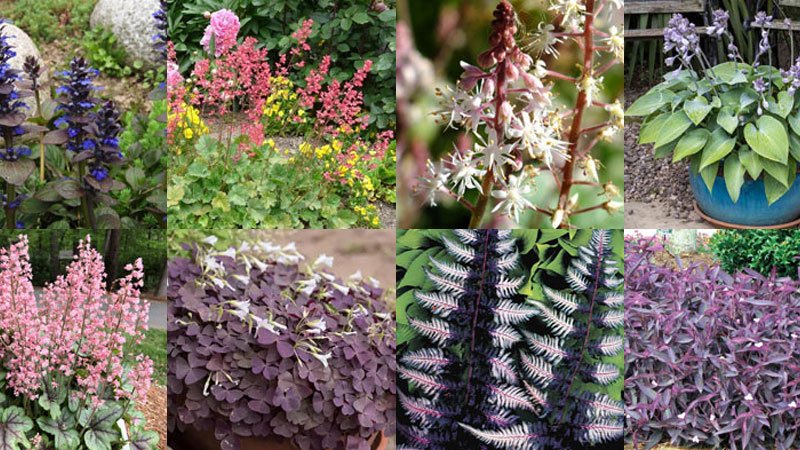
Purple Coral Bells (Heuchera spp.):
These evergreen plants are usually found with lushly colored leaves of purple shade, with their tender spikes of flowers in beauties of pink or white. They love the place under the trees or in moderately shaded areas, as well as in soil that drains well, making them good choice for a border or woodland garden.
Bugleweed (Ajuga reptans):
Transforming low -growing perennial, one formed with mat of dense, shiny, purple -green leaves and holding small spikes of blue-purple flowers in spring. Ideal for shady areas and perfectly happy in shade from partial to full shade, the bugleweed does well in moist, well-drained soil.
Japanese Painted Fern (Athyrium niponicum ‘Pictum’):
The bold silver-purple leafage and the flowery fronds of this fern make it a perfect accent for shaded gardens. It is a shade to the sun preferring plant and it grows well in moist, well-drained soil which makes it perfect for the woodlands and shaded borders.
Purple Heart Vine (Setcreasea pallida):
This trailing plant displays beautiful purple leaves, and it is best suited for shady zones in the garden. It can be planted in between plants on the ground or even in containers adding a splash of color to shady places.
Purple Shamrock (Oxalis triangularis):
The plant is a distinctive looking one with its leaves shaped like a triangle and with pretty pinkish-purple flowers and does well in shaded areas with indirect light. It is better for moist, well-drained soil and great for adding colour to the shady borders and containers.
Japanese Forest Grass (Hakonechloa macra):
A graceful species of grass, cascades as arched smoke rings of foliage shades of green and purple. This plant just loves from partial to full shade and moist, well-drained soil, making it an ideal filler for shaded borders or woodland gardens.
Purple Hellebore (Helleborus spp.):
Hellebore, also known as Lenten Rose, adds a special touch to any landscape with its graceful flowers in purple, pink or ivory hues. It blooms in mid to late winter to early spring and likes partial or full shade in well-drained soil such as sandy or medium soils, so it is ideal for shady borders or woods.
Hosta (Hosta spp.):
Hosta is a favorite of many due to its beautiful leaves and ability to produce neat in the shade, unlike most other plants. The collection contains many varieties of purple leaves alongside variegated ones that will bring interest and color to the shade.
Coral Bells (Heuchera spp.):
These plants with long-lasting growth highlight their purple-colored foliage surrounded, sometimes, by fine spikes of flowers that come in different patterns of pink or white. They are well adapted to partial shade and well-drained soil, that mean they make great plantings for shaded side borders and woodland gardens.
Foamflower (Tiarella spp.):
This spring ephemeral has blossoms in white or pink hues, growing on slender stems and alternating with deeply cut green to purply leaves. It flourishes in partial to full shade and in moist, well-drained soil, thus enhancing garden aesthetics in shaded regions or woodlands.
Vine Purple Leaf Plants
Last but not least, we have arrived at a very peculiar species of Purple Leaf Plants that are very beautiful and majestic when handled with care but if you let them grow without any attention, they will spread out wide and long. Keeping this under mind, I present to you the “Vine Purple Leaf Plants”:
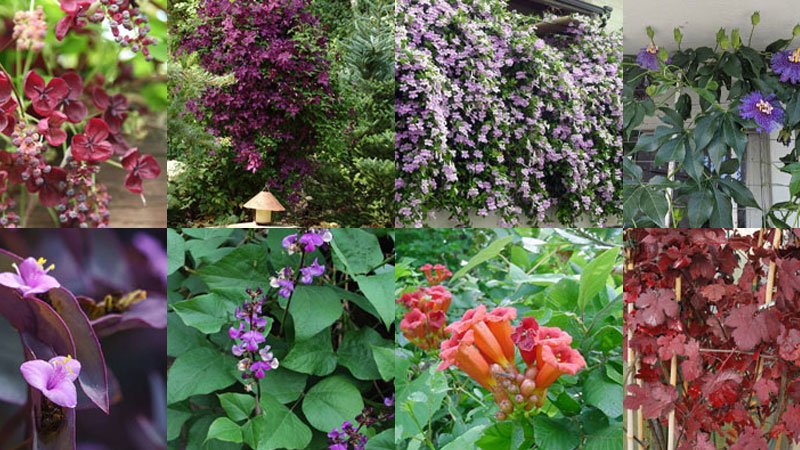
Purple Hyacinth Bean (Lablab purpureus):
This fast-growing vine has clusters of fragrant violet flowers followed by purple pods. It is characterized by the heart-shaped foliage and the dark purple shade, making it a beloved garden decoration.
Purple Trumpet Vine (Campsis radicans ‘Purpurea’):
This vine has its fast-growing nature which makes it any garden to be decorated with its trumpet-shaped purple flower. It is very popular with hummingbirds and butterflies and grows… It is best suitable for full sun and well drained the soils.
Purple Bell Vine (Rhodochiton atrosanguineum):
A member of the genus Ipomoea, being a tender perennial vine, develops drooping, bell-shaped flowers of mauve color with dark purple leaves. Suitable for containers, baskets or trellises in shade areas should be taken into account.
Purple Passionflower (Passiflora incarnata):
The grapevine is twining and adorned with purple-and-white inflorescences with a great passionflower-like shape. It actually blooms during the summer and pollinators such as butterflies and bee come around. This happens in the full sun to partial shade with good drainage soil.
Purple Queen (Setcreasea pallida):
While not a true vine, Purple Queen is a succulent with the fantastic deep purple spreading foliage that can be trained to climb/cascade over trellis or hanging baskets. It is ideally grown in full sun to partial shade and is a nice way of injecting some color into your garden.
Clematis ‘Niobe’:
This gorgeous vine is loaded with big purple flowers with yellow stamen to contrast their color giving your garden a dramatic impression. It begins blooming in late spring and continues until midsummer. It requires full sun with engraved roots and well-drained soil.
Akebia quinata:
whose other common name is “Chocolate Vine,” produces clustered, fragrant flowers that are chocolate-purple in color in early spring. It has discretely ornamental palmate foliage that is suitable for covering fences, arbors, or pergolas in partial shade to full sun.
Clytostoma callistegioides:
Also called as the Trumpet Vine, it is an evergreen vine that flowers in clusters with purple-lavender color and a sweet aroma. Featuring a bloom period from spring to summer, it likes full sun and well-drained soil, making it perfect for trellis or pergola planting.
Lathyrus odoratus ‘Black Knight’:
This sweet pea type has deep purple color flowers forming long vines, which are covered with a fragrance and also add beauty to the garden. From late spring to early summer, it blooms and grows in full sun with well-drained soil support.
Vitis vinifera ‘Purpurea’:
Prosit Grape is another name of this vine which is the producer of edible grapes and deep purple leaves which turn fiery red in fall. Like the majority of ornamental flowers, it loves full suns and good drainage, therefore, it is great for arbors and pergolas decoration.
Conclusion:
As we came to the end of our exploration of the amazing world of purple leaf plants, we were caught up in the deep enchantment of the magnificence of the infinite possibilities that it held. From the majestic spokes of Purple Heart vines cascading from hanging baskets to the passionate flames of Purple Hyacinth Beans climbing trellises, these botanical masterpieces have captured our hearts and our souls. As protectors of the earth, let us carry on guarding and nurturing these fascinating adornments that will remain beautiful for our descendants. Deep within this kaleidoscope of life where every color relives a story and every leaf speaks of an ancient wisdom, purple leaf plants stand as immortal symbols of grace, strength, and unlimited powers of nature. Thus, let us set forth again with renewed respect and admiration for these works-of-art which are yet living, for in their presence the beauty of nature will once more enthral and excite us.

